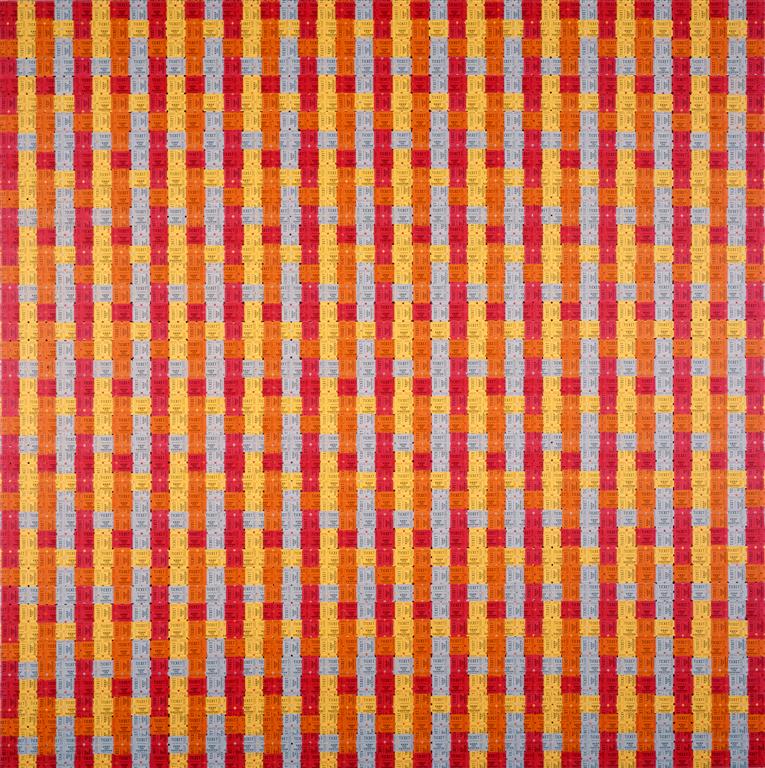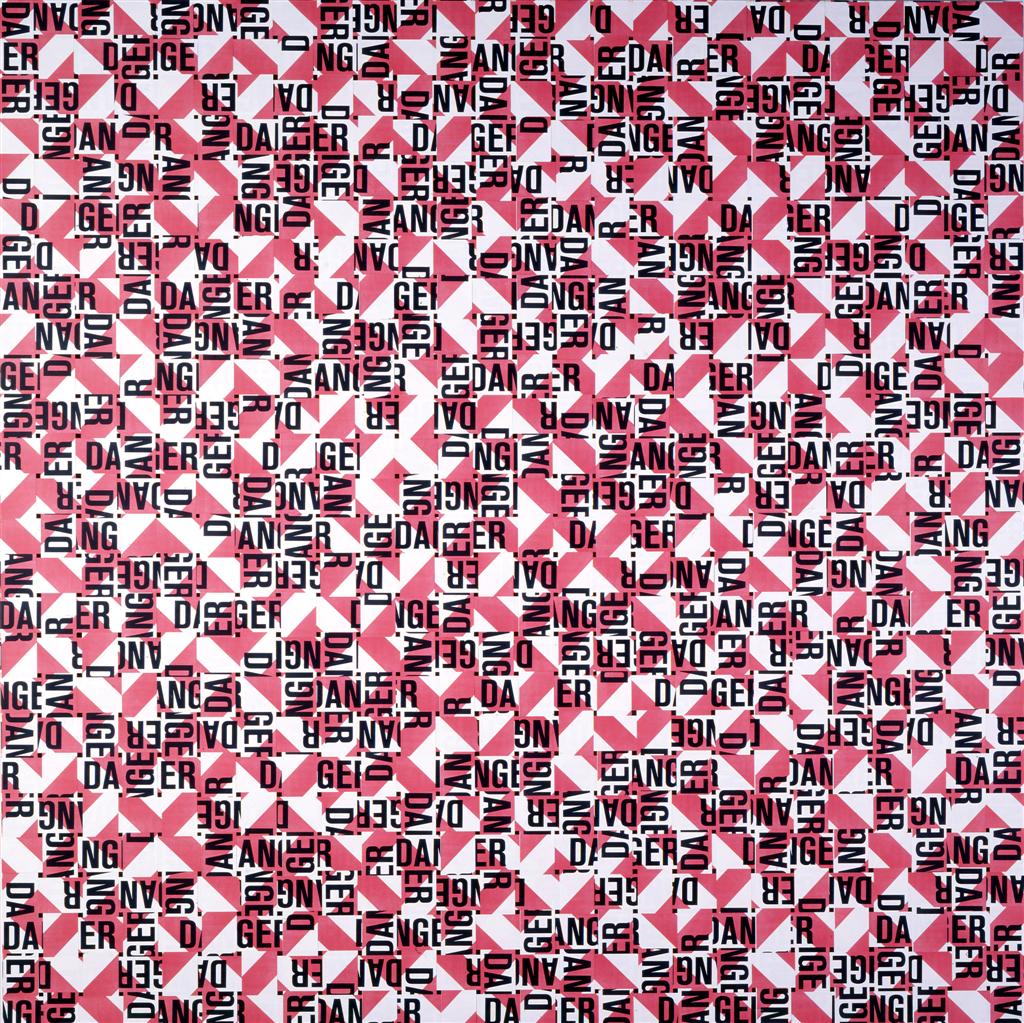David Szafranski
Published: May, 1994
My current body of work originated several years ago with a roll of red, black, and white nylon lawnchair webbing I found at Wal-Mart . It became part of a disfigured and exaggerated "modern" sculpture that mimicked and parodied an aluminum lawnchair. Five years later, this webbing became the basis for my ongoing production of woven stretchers, incorporating flat rolled stock such as tickets, nylon webbing, or strapping materials.
The history of using mass produced items for aesthetic purposes goes back almost one hundred years to the cubists and Russian constructivists. More recently, the minimalists used industrial materials such as plastic, aluminum, felt, Plexiglas and so forth. They had very rigid views on how these materials should be used and they issued guidelines and policies on such matters, much like Mondrian's requirement that horizontal and vertical lines be used in combination only with primary colors and black and white. Minimalist sculpture seemed like leftover bits and pieces of Bauhaus architecture. It might be said that I am just revisiting the graveyard of minimalism, but I would add that I have found life in the decayed remains.
The minimalists were primarily interested in geometric sculptural forms. Their line of austere, well-crafted, machine-made looking objects had a heightened intellectual aura, but were diminished in vitality and animation. They purposely chose to use emotionally neutral materials—things that were obviously man-made, but had no associative connections to human events or feelings. This choice allowed them to construct work which they envisioned could stand apart from the artist's personality or from social or political realities. Their denial of involvement with the larger culture is transparently a form of escapism.
Looking back, the minimalists haughty attitude is as much a part of their work's "content" as their ideas about primary structures and physical space. In the current humbler era, few of us believe that artists can escape from the time and context in which they are working—content and meaning, like history, changes with time and are extremely elusive.
By arrogating the square, the grid, and the woven repetitive pattern, I am able to refocus attention on some of the issues regarding hand-crafted versus mechanically-made forms. I am also cross-pollinating the gender association of weaving as "women's work" with large-scale patriarchal square stretchers, i.e. "male painting." When I re-inject suggestive and narrative materials into the modernist grid, it begins to mirror and exaggerate my personal world view—as well as realize the Taoist perspective of the interconnectedness of "10,000 things".
The weaving technique provides a meditative, almost hypnotizing surface. This mesmerizing effect can be observed in other visual mediums—video for example— which serve to numb and distract people from deeper emotional issues, familial obligations, and social problems. 24,000 Inches of Adult Videos which alludes to TV watching and sexual obsession, is made from VHS video tape. The shiny black surface of this work is highly reflective; so, in effect, viewers can see their reflections on "pornographic video." Of course, there are no "dirty pictures" to see in the tape— without a VCR to decode it, the tape is rendered "blind."
 A work entitled Extra Large Four Color Tickets, is
made up of "Admit One" tickets of various colors woven
together. The sheer quantity of tickets in this work
brings to mind our collective public withdrawal into
cinemas or theaters (or even "Blockbuster" art
exhibits), and how we regularly confuse live personal
experiences with the mediated experiences from TV and
movies. The perforated ticket rolls, made from cheap
cardstock paper, are colored with inexpensive industrial
dyes. This makes Extra
Large extremely fragile and sensitive to
sunlight. Like the modern TV or movie watcher, Extra Large,
ideally, should be kept in the dark.
A work entitled Extra Large Four Color Tickets, is
made up of "Admit One" tickets of various colors woven
together. The sheer quantity of tickets in this work
brings to mind our collective public withdrawal into
cinemas or theaters (or even "Blockbuster" art
exhibits), and how we regularly confuse live personal
experiences with the mediated experiences from TV and
movies. The perforated ticket rolls, made from cheap
cardstock paper, are colored with inexpensive industrial
dyes. This makes Extra
Large extremely fragile and sensitive to
sunlight. Like the modern TV or movie watcher, Extra Large,
ideally, should be kept in the dark.
An excruciatingly bright, red flocked tightly woven ribbon comprises Is It Fear or Desire. It is painful to look at, yet at the same time, its softly textured surface is extremely seductive—making it visually addictive. This flocked ribbon appears from October through December in mega-malls and on wreaths during our annual Xmas consumer orgy. The work's potency serves as a visual analogue for the subliminal visual energy—telling us to spend—that bombards us in every media form during this period of mass psychosis.
 Other rolled stock materials
that I've used set up boundaries of safety. Two examples
are yellow and black nylon barrier tape, or red and
white paper safety tape imprinted at regular intervals
with the word DANGER. I selected these safety tapes from
industrial safety catalogs which provide a wide range of
products required by OSHA to keep employees aware of
potential safety problems in their environment. By
weaving these materials, the messages become mixed up,
garbled and confused such as in Danger—or even
totally transformed from a visual warning into retro
Op-Art as in High
Visibility Barrier. These pieces also comment
on the arbitrariness of the boundaries (as in issues of
free speech and censorship) that penetrate all areas of
our culture.
Other rolled stock materials
that I've used set up boundaries of safety. Two examples
are yellow and black nylon barrier tape, or red and
white paper safety tape imprinted at regular intervals
with the word DANGER. I selected these safety tapes from
industrial safety catalogs which provide a wide range of
products required by OSHA to keep employees aware of
potential safety problems in their environment. By
weaving these materials, the messages become mixed up,
garbled and confused such as in Danger—or even
totally transformed from a visual warning into retro
Op-Art as in High
Visibility Barrier. These pieces also comment
on the arbitrariness of the boundaries (as in issues of
free speech and censorship) that penetrate all areas of
our culture.
The notion of craft comes up in this work due to its direct woven nature. Art critic Janet Tyson has observed that the works "allude to sublime, monumental tapestries and day camp projects such as pot holders." She suggests that they are "craft" in that what the viewer sees and the materials used to make the object are one and the same. However, much like video tape, the information (or in some cases, misinformation) contained in each piece is encoded in the materials. By amplifying the unusual features of the materials through obsessive repetition, the emotional charge, bias, and irony becomes exaggerated. The works become self-mocking—visual jokes in the tradition of the farceur.